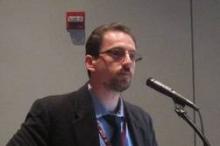CHICAGO – Intensive counseling and other nonpharmacologic strategies to quit smoking dramatically increased abstinence rates among elderly long-term-care residents in a multicenter study.
Among 74 current smokers, 34 residents (46%) successfully quit smoking and 26 (35%) remained tobacco free at 1 year.
Prior research shows that medical advice to quit smoking typically produces 1-year abstinence rates of 5% to 10%.
"With a 46% quit rate, we were successful in showing that pharmacologic therapy isn’t the only way," Dr. Aleksander Shalshin said at the annual meeting of the American College of Chest Physicians.
Smokers over the age of 60 years represent about 23% of current smokers and are at increased risk of dying from disorders related to smoking. A recent prospective study found that the risk of dying from cancer, cardiovascular disease, and respiratory disease was 50% higher among men who continued to smoke into their 70s than for never-smokers.
Further, recent studies in the United States and England have shown that smokers who quit at either age 60 or age 65 years gained 2.7-3.7 years of life, said Dr. Shalshin, a pulmonary and critical care physician with North Shore Long Island Jewish Health System, in Syosset, N.Y.
"I always tell my patients it’s never too late to be a quitter," he said.
For the current study, the investigators prospectively recruited 74 long-term-care residents, aged 65-78 years, who were currently smoking an average of half a pack of cigarettes a day and had a tobacco history of more than 5 years. All were interested in quitting.
The intervention included daily smoking-cessation counseling visits from their primary care physician, nurse, or nurse educator, and regular access to a pulmonary consultant.
Counseling was supplemented with educational self-help, video and printed materials and the facilities set up smoke-free zones within 50 feet of their entrances. Participant’s families were also encouraged to provide support and received education on the benefits of a multifaceted approach to tobacco-addiction treatment.
"For patients in long-term-care facilities, where access is immediate and often easy, you don’t have to wait for the next appointment. It can be done on a daily basis with a little bit of time and effort." Dr. Shalshin said.
Session co-moderator Dr. Linda Efferen, chief medical officer, South Nassau Communities Hospital, Oceanside, N.Y., said targeting this captive audience makes sense and provides a bigger bang for the buck.
"These are our future readmissions, especially if they have underlying COPD [chronic obstructive pulmonary disease], asthma, or heart disease," she said in an interview. "To do this without pharmaceuticals and get these results is just phenomenal. We’re in the antipolypharmacy mode also because most of our patients are already on 20 different medications."
Pharmaceutical options will be used in the next phase of the study, however, to target the remaining patients who were unable to quit with the multidisciplinary nonpharmaceutical approach, Dr. Shalshin said in an interview.
Dr. Shalshin and his coauthors reported having no financial disclosures.


